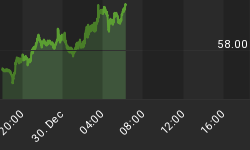With U.S. homebuilder confidence slipping to a 16-year low in June and subprime contagion fears omnipresent, no one seemed to notice when Toll Brothers reported a 93.5% increase in its 'Provision for inventory write-downs/write-offs' for the six-months ending April 2007. However, as the losses and/or inventory write-downs at Toll and other builders mount in the coming quarters, the carnage could prove difficult to ignore. After all, following more than a decade of truly spectacular gains, the good times for U.S. homebuilders are over.

As one of the most hated and heavily shorted industries today, there will undoubtedly be terrific bounces in homebuilding stocks going forward. Moreover, if builder's can somehow smoothly manage a wind-down in operations and/or the 'great' U.S. housing bust proves less than great, there is the possibility, however remote, that front running such bounces could be a worthwhile pursuit.
But alas, to analyze the homebuilder group based upon speculations of a forthcoming 'bottom' in the housing market could prove exceptionally dangerous. Quite frankly, with business fundamentals unlikely to improve until at least spring 2008, dancing in homebuilder stocks is probably best left to speculators and/or thrill seekers. This conclusion noted, researching and watching the group requires no upfront fees, and could help pave the way for an opportunistic closing tomorrow.
Leaks In The Data
From a basic book value perspective U.S. homebuilders are already in the kill zone, with 6 out of the top 12 companies currently trading below tangible book value. However, given that this is an industry that has grown without taking any breaths for more than a decade, the trailing book value figures could prove very misleading. Remember that we are less than two reported quarters into the bust, an exceptionally difficult phase to comprehend.

As a quick example of how difficult it is to value a homebuilder take Pulte Homes: a $5.5 billion investment today gets you nearly $6 billion in tangible equity - seemingly a good deal. However, with more than $9.4 billion in 'House and land inventory' and an additional $422 million in 'Land held for sale' (not to mention nearly a billion in 'other assets' that may be cleaned up in the company's next 10K), Pulte can hardly be summed up by placing trust in its parts. Worth less than a billion dollars before the boom 6-years ago, is PHM really worth paying $5.6 billion for today?
Data Be Damned!
For those convinced that the slide in homebuilder stocks represents a value opportunity right now, there are some basic tools that could prove helpful. First and foremost, the balance sheet may provide clues as to which company's are best prepared to face what could be a prolonged storm. For example, if you assume a 20% inventory mark-down (and/or 20% hit to equity via a combination of write-downs and losses), the group can be viewed in a more telling light (compared to basic book value figures).

Using the above stress tests, KB Home - which managed to trim inventories by $1.05 billion sequentially for the three months ended May 31 with only a $0.152 billion hit to shareholders' equity ... is the most expensive inventory story. This means that if the housing bust turns out to equally dire for all concerned (admittedly very unlikely) KBH's shares could theoretically suffer the most. Conversely, the number one homebuilder 'bargain' using the above methodology is Beazer Homes, which is trading only slightly above book even when assuming a '20% haircut'. Perhaps utilizing a similar approach, Moore Capital Management LLC recently acquired a 5.1% in Beazer, a potentially astute contrarian position if the worst does not come to pass...
Conclusions
With starkly differing business focuses ... not to mention companies like Toll trying to play a new geographical card in 'China'* - obviously the above calculations assume a lot. These limitations notwithstanding, in order to surmise that any homebuilder represents a 'bargain' - or a below book value long-term investment opportunity ... you must conclude that asset write-downs will not be more than 20% and sales/losses will stabilize by summer 2008. Unfortunately such a conclusion is not one we are willing to make.
The U.S. housing market spent the last U.S. recession kicking off an unprecedented boom and in 2005/2006 a massive wave of speculators entered the real estate market. Realizing that unsustainable booms inevitably turn to busts, and that many speculators and ill-fated borrowers have yet to face the music, conjuring up images of a bottom in 2007 is impossible to do.
Incidentally, we could be coaxed to ignore the macro and focus more closely on the individual businesses if widespread selling chaos was present in the homebuilder stocks. Unfortunately, and despite some dramatic share price declines, no company is trading at fundamentally distressed levels unless you believe the worst is nearly over (as with all corporate turnarounds, the best builders will rebound well before the broader industry does). To reiterate, when it comes to U.S. homebuilders, speculators and thrill seekers only need apply.
Disclosure: No one at FallStreet.com has any investment position in any of the companies mentioned above.
















